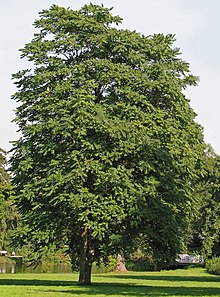
Back أيلنط باسق Arabic ايلنط باسق ARZ Ailanthus altissima AST Uca aylant Azerbaijani Айлант Bulgarian আইলান্থাস আলতিসসিমা Bengali/Bangla Ailant Catalan Ailanthus altissima CEB Pajasan žláznatý Czech Coeden y nefoedd Welsh
| Tree of heaven[1] | |
|---|---|

| |
| Large specimen growing in a park in Germany | |
| Scientific classification | |
| Kingdom: | Plantae |
| Clade: | Tracheophytes |
| Clade: | Angiosperms |
| Clade: | Eudicots |
| Clade: | Rosids |
| Order: | Sapindales |
| Family: | Simaroubaceae |
| Genus: | Ailanthus |
| Species: | A. altissima
|
| Binomial name | |
| Ailanthus altissima | |
| Synonyms[2] | |
| |
Ailanthus altissima /eɪˈlænθəs ælˈtɪsɪmə/ ay-LAN-thəss al-TIH-sim-ə,[3] commonly known as tree of heaven, Ailanthus, varnish tree, copal tree, stinking sumac, Chinese sumac, paradise tree,[4] or in Chinese as chouchun (Chinese: 臭椿; pinyin: chòuchūn), is a deciduous tree in the family Simaroubaceae.[1] It is native to northeast and central China, and Taiwan. Unlike other members of the genus Ailanthus, it is found in temperate climates rather than the tropics.
The tree grows rapidly, and is capable of reaching heights of 15 metres (50 ft) in 25 years. While the species rarely lives more than 50 years, some specimens exceed 100 years of age.[5] Its suckering ability allows this tree to clone itself indefinitely.[6] It is considered a noxious weed and vigorous invasive species,[1] and one of the worst invasive plant species in Europe and North America.[7] In 21st-century North America, the invasiveness of the species has been compounded by its role in the life cycle of the also destructive and invasive spotted lanternfly.[8][9]
- ^ a b c "Ailanthus altissima". CABI. 6 November 2018. Retrieved 13 July 2019.
- ^ "The Plant List".
- ^ Cite error: The named reference
oedwas invoked but never defined (see the help page). - ^ Cite error: The named reference
SRS-062was invoked but never defined (see the help page). - ^ Wickert, K. L.; O'Neal, E. S.; Davis, D. D.; Kasson, M. T. (2017). "Seed Production, Viability, and Reproductive Limits of the Invasive Ailanthus altissima (Tree-of-Heaven) within Invaded Environments". Forests. 8 (7): 226. doi:10.3390/f8070226.
- ^ Collin, Pascal; Dumas, Yann (2009). "Que savons-nous de l'ailante (Ailanthus altissima (Miller) Swingle)?" [What do we know about A. altissima?]. Revue Forestière Française. 61 (2): 117–130. doi:10.4267/2042/28895. Cite: Mais comme le fait remarquer Kowarik (2007), sa reproduction végétative le rend en quelque sorte très longévif, le premier individu introduit aux États-Unis en 1784 étant toujours présent grâce à ses drageons. (But as it is mentioned by Kowarik (2007), vegetative reproduction makes [A. altissima] very long-lived, in a way. The first individual planted in the United States in 1784 is still there thanks to its suckers.)
- ^ Cite error: The named reference
Sladonjawas invoked but never defined (see the help page). - ^ "Tree-of-heaven and the Spotted Lanternfly: Two Invasive Species to Watch". Pennsylvania State University. 28 August 2018.
- ^ "Invasive Species Spotlight: Tree-of-Heaven (Ailanthus altissima) and Spotted Lanternfly (Lycorma delicatula) | Brandywine Conservancy and Museum of Art".
© MMXXIII Rich X Search. We shall prevail. All rights reserved. Rich X Search